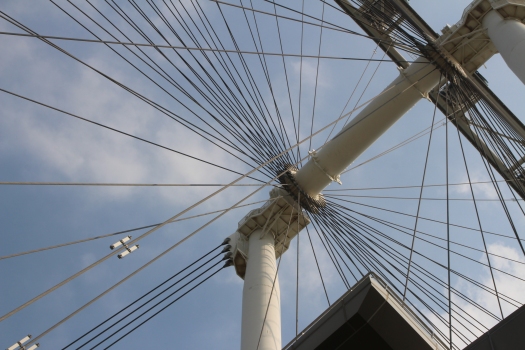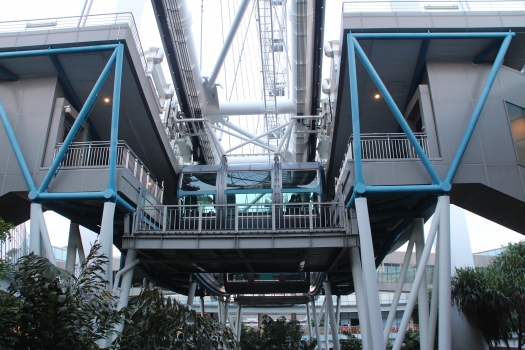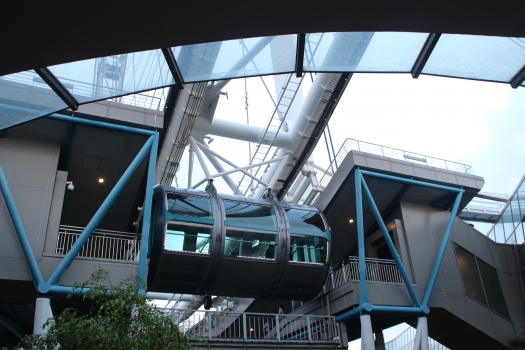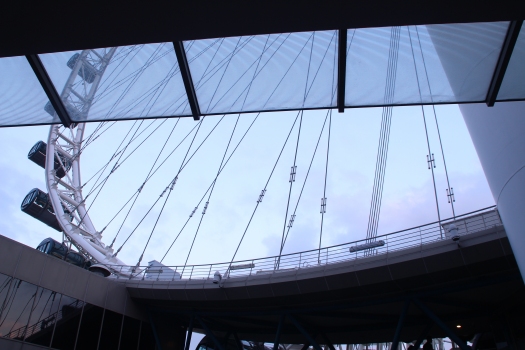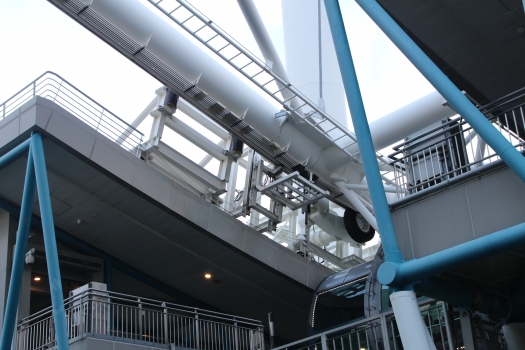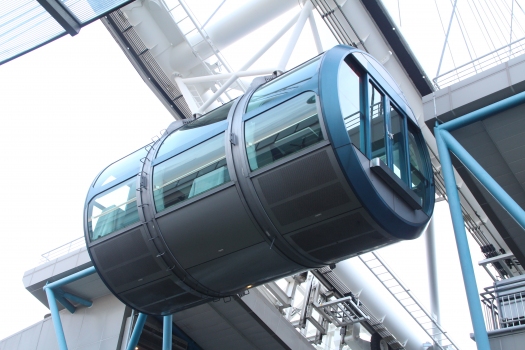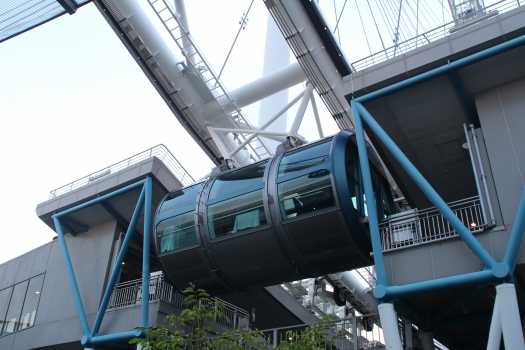General Information
Project Type
| Function / usage: |
Ferris wheel |
|---|---|
| Material: |
Steel structure |
Location
| Location: |
Singapore |
|---|---|
| Address: | 30 Raffles Avenue |
| Coordinates: | 1° 17' 21.84" N 103° 51' 46.80" E |
Technical Information
Dimensions
| diameter | 150 m | |
| height | 160 m | |
| seats | 784 | |
| number of cabins | 28 | |
| number of passengers per cabin | 28 |
Cost
| cost of construction | Singapore dollar 240 000 000 |
Excerpt from Wikipedia
The Singapore Flyer is a giant observation wheel at Downtown Core, Singapore. It opened in 2008, with construction having taken about 2½ years. It carried its first paying passengers on 11 February, had a soft opening to the public on 1 March, and was then officially opened on 15 April. It has 28 air-conditioned capsules, each able to accommodate 28 passengers, and incorporates a three-storey terminal building.
The Flyer has an overall height of 165 metres (541 ft) and was the world's tallest Ferris wheel until the 167.6 m (550 ft) High Roller, which is 2.6 m (9 ft) taller than the Flyer, opened on the Las Vegas Strip in Nevada, US, on 31 March 2014. The previous record holder, the Star of Nanchang, in Jiangxi, China, is 160 m (525 ft) tall, although its 153 m (502 ft) diameter wheel is larger than the Flyer's 150 m (492 ft) wheel.
Early history
The Singapore Flyer was first conceived in the early 2000s by Patrick MacMahon of Melchers Project Management, a subsidiary of German company Melchers. Formal planncommenced in 2002. A new company, Singapore Flyer Pte Ltd, was formed as the developer, with Melchers Project Management holding a 75% stake, and the remainder held by Orient & Pacific Management.
The project was formally announced and endorsed on 27 June 2003 by the Singapore Tourism Board with the signing of a memorandum of understanding, formalising the understanding between the developer and tourism board with regard to the land-acquisition process. Under this agreement, the tourism board was to purchase the plot of land in Marina Centre from the Singapore Land Authority, and lease it to Singapore Flyer Pte Ltd for 30 years with an option to extend the lease by another 15 years. The land was to be rent-free during the construction phase of the project. In July 2003, Jones Lang LaSalle was appointed as the real estate advisor. Takenaka and Mitsubishi were selected as the main contractors, and Arup as the structural engineer.
Early designs showed a 169 m (554 ft) tall wheel similar to the London Eye, drawing criticism that it lacked originality. The developers pointed out that the design was not finalised and was merely for conceptualisation purposes, though the final project changed little from the early designs. Subsequently, the project was to grind almost to a halt when the developer faced difficulties in sourcing funds to build the wheel. Original plans to complete the wheel by the end of 2005 were thus postponed indefinitely, and there were reports (denied by the Singapore Tourism Board) that the tourism board has set an ultimatum date of 31 March 2005 for the developer to iron out its financial issues and to keep the development going.
By September 2005, the project was revived when funds were successfully sourced from two German banks. Collin William Page, a subsidiary of ABN AMRO, was to provide equity to a maximum of S$100 million, with a further S$140 million coming from HypoVereinsbank. With this injection of S$240 million, the largest single foreign investment in the Singaporean entertainment industry, construction was slated to begin by the end of the month. The stakeholders then were AAA Equity Holdings, Melchers Project Management, and Orient & Pacific Management.
In August 2007, Florian Bollen, Singapore Flyer Pte Ltd chairman, raised his stake in the Singapore Flyer from 60% to 90% through acquisition of Melchers Project Management's 30% stake. The deal was done via AAA Equity Holdings, a private investment vehicle headed by Bollen. Orient & Pacific Management, which spearheaded the project development management, owns the remaining 10%.
Design
The development has a gross building area of approximately 16,000 m² (172,000 sq ft), built on a 33,700 m² (362,700 sq ft) site along the Marina Promenade. Designed by Arup and Mitsubishi Heavy Industries with a capacity of up to 7.3 million passengers a year, the normally constant rotation of the wheel means that a complete trip lasts approximately 32 minutes.
The Flyer's 28 air-conditioned capsules are mounted outboard of the rim of the wheel structure, providing continuously unobstructed views. Each capsule has a floor area of 26 m² (280 sq ft) and is capable of holding 28 passengers, or up to five wheelchairs and 15 other visitors when booked in advance for use by disabled guests.
The wheel initially rotated in a counter-clockwise direction when viewed from Marina Centre, but on 4 August 2008 this was reversed on the advice of Feng shui masters.
Wheelchair ramps and lifts, handicapped toilets, and a dedicated parking lot for the disabled are also provided.
Construction
The groundbreaking ceremony was held on 27 September 2005, with Mah Bow Tan, then Minister for National Development, as guest of honour. The spindle was fitted on 13 December 2006, and the outer rim was completed on 9 April 2007. Installation of the passenger capsules began on 3 August 2007and was completed on 2 October 2007.
Opening
The Flyer opened in 2008. During Chinese New Year, corporate 'inaugural flights' were held from 11 to 13 February, and tickets for which sold out for S$8,888, an auspicious number in Chinese culture. The first public rides were on Valentine's Day, 14 February, the soft launch on 1 March, and the official opening on 15 April, at which Prime Minister Lee Hsien Loong was the guest of honour.
Breakdowns and stoppages
- In July 2008, the Flyer was stopped because of a minor fault in the braking system.
- On 4 December 2008, the wheel was stuck for nearly five hours due to bad weather and some 70 people were stranded.
- On 23 December 2008, the wheel stopped and trapped 173 passengers for about six hours. The breakdown was caused by a short circuit and fire in the Flyer's wheel control room, which cut off the air-conditioning in the wheel. Eleven passengers were evacuated via a sling-like device from a few of the capsules, and those stranded were given food and drink. The wheel restarted nearly seven hours after it had stopped and two people were hospitalized. The Flyer was closed indefinitely and an investigation into the cause of the malfunction was launched. The wheel re-opened on 26 January 2009 after the Singapore Police received the final safety certification report from the Conformity Assessment Board. Following this breakdown, additional back-up systems costing about $3 million were installed. These included a generator, winches, three anti-fire and smoke systems, and heat detection devices.
- On 18 July 2010, the ride was shut after one of its electrical cables supplying power to the air-conditioning systems was struck by lightning, affecting the air-conditioning system. Some 200 passengers had to be evacuated. The Flyer re-opened on 20 July 2010 after repair work was completed.
- On 20 June 2013, operations were temporarily suspended to protect employees from record-high pollution levels in Singapore, the first time the Flyer had shut due to haze.
- On 25 January 2018, operations were suspended due to a technical issue. All 61 passengers on board were brought to ground safely when the incident occurred at about 9 am. Operations resumed two months later on 1 April.
Financial difficulties and acquisition
In March 2010, Great Wheel Corporation, a consultant for the Singapore Flyer, was one of several companies named in a report alleging embezzlement, lodged with the prosecutor's office in Berlin, Germany. Transfers of €3 million to companies in the Virgin Islands and UK, and monthly payments of €40,000 from the Berlin wheel's project company, Great Berlin Wheel, to its linked company Great Wheel in Singapore, are questioned. A prosecutor's office spokesperson said: "We understand there were false contracts concerning non-existing deals, and these contracts were made to take the money for private concerns."
Florian Bollen is chairman of both Great Wheel Corporation, registered in Singapore as GWC Holdings, and Singapore Flyer Pte Ltd. A spokesperson for the Singapore Flyer said: "The giant observation wheel in Berlin is separate from the Singapore Flyer and it is separately owned and operated. Great Wheel Corporation is also a separate entity from the Singapore Flyer. Any investigations relating to the Berlin wheel and Great Wheel Corporation have no effect on and no relationship with the Singapore Flyer's operations and finances."
On 28 May 2013, the Singapore Flyer announced that it was in receivership. Accounting firm Ferrier Hodgson has been appointed as the receiver and manager of the company's charged assets. Ferrier Hodgson said it is looking into identifying investors to manage and enhance the Singapore Flyer, and will ensure smooth operations at the Flyer throughout the receivership.
On 2014, Merlin Entertainments, the British firm behind the famous London Eye and Legoland theme parks abandoned its talks to acquire the S$240-million tourist attraction located in the city of Singapore. The discussions between the receiver, Ferrier Hodgson and Merlin Entertainments were reported to have begun but the talks between the two parties had broken down. The Singapore Tourism Board reportedly said that discussions are still ongoing with other stakeholders, although it declined to confirm if the talks were with another potential buyer. This crumpled the future for the observation wheel, which have gone through financial difficulties since 2010.
On 28 August 2014, Straco Leisure Pte. Ltd. announced the acquisition of Singapore Flyer. Straco Leisure Pte. Ltd. is 90% owned by Straco Corporation Limited, a Singapore listed company that operates tourist attractions in China such as the Shanghai Ocean Aquarium and Underwater World Xiamen. The remaining 10% is owned by WTS Leisure Pte. Ltd., one of the largest private tour bus operators in Singapore.
Text imported from Wikipedia article "Singapore Flyer" and modified on July 23, 2019 according to the CC-BY-SA 4.0 International license.
Participants
Relevant Web Sites
Relevant Publications
- (2008): The Singapore Flyer. In: The Arup Journal, v. 43, n. 2 ( 2008), pp. 2-14.
- (2009): The Singapore Flyer and Design of Giant Observation Wheels. In: Structural Engineering International, v. 19, n. 1 (February 2009), pp. 12-16.
- About this
data sheet - Structure-ID
20025741 - Published on:
05/01/2007 - Last updated on:
02/03/2023


